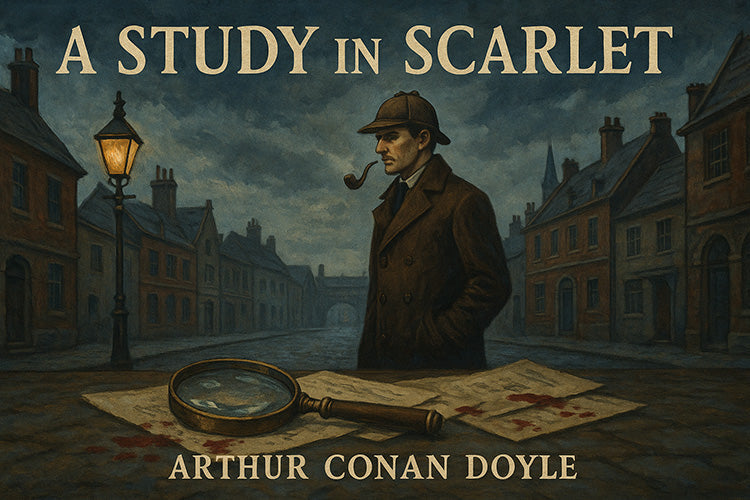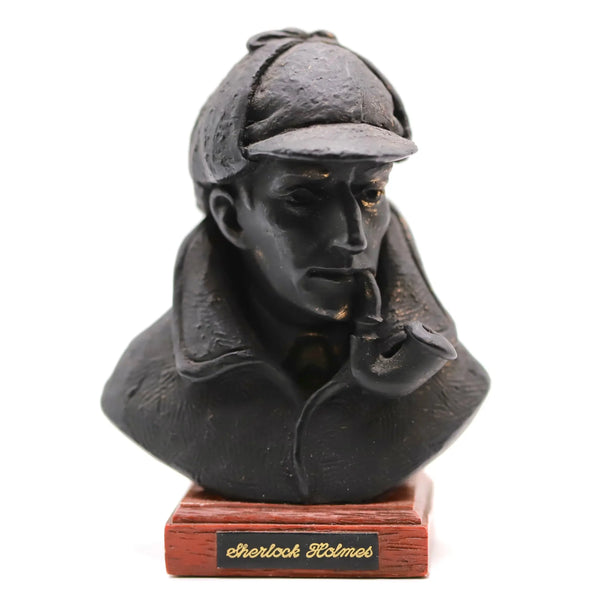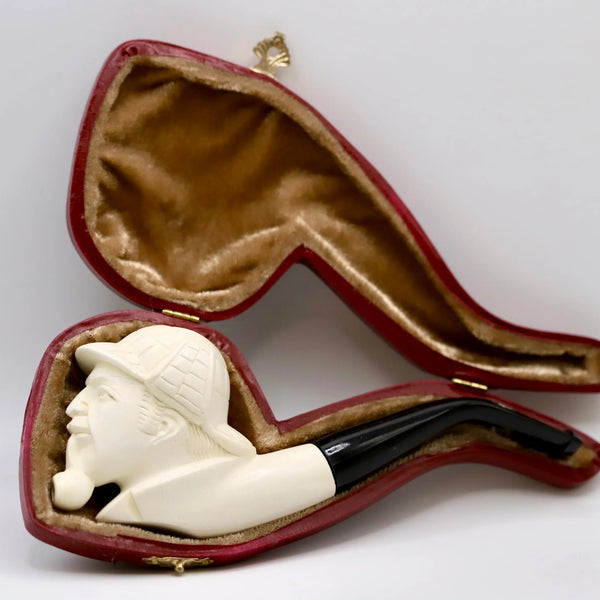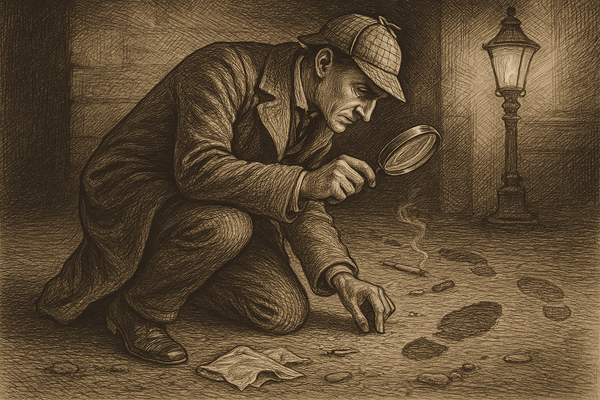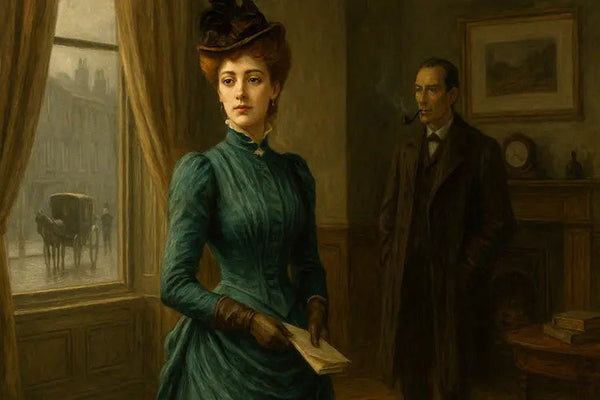Published in 1887, “A Study in Scarlet” marked a revolutionary moment in literature, introducing the world to Sherlock Holmes and fundamentally transforming detective fiction forever. This first story in the Sherlock Holmes series established not merely a character but an entire methodology of crime solving that would influence both literature and real-world investigation.
Sir Arthur Conan Doyle, author Arthur Conan Doyle, debuted with this novel, introducing readers to the brilliant consulting detective and his loyal companion, setting the foundation for what would become one of literature’s most enduring partnerships and most celebrated series of detective stories. The Sherlock Holmes series and the original stories by Conan Doyle serve as the foundation for countless later adaptations and works.
Summary
• Literary Revolution: A Study in Scarlet established the template for modern detective fiction, introducing scientific methods of criminal investigation and the concept of the consulting detective that influenced countless subsequent crime fiction works. Holmes’s commitment to exact knowledge and the proper study of criminal investigation set a new standard for realism and precision in the genre.
• Character Origins: The novel presents the first meeting between Holmes and Watson at Baker Street, establishing their legendary partnership and introducing Holmes’s famous “brain attic” theory of knowledge and his revolutionary approach to deduction. Holmes’s pursuit of definite and exact knowledge and his passion for an accurate idea in his scientific methods are central to his character and investigative success.
• Structural Innovation: The narrative is divided into Part I and Part II—the first part presents a London murder mystery, while Part II shifts to an American West backstory. The significance of Part II lies in its introduction of backstory and alternate settings, adding depth and moral complexity to what could have been a simple crime story, and showcasing Doyle’s ambitious storytelling approach.
• Cultural Impact: As the first Sherlock Holmes novel, it laid the groundwork for the entire Holmes canon, establishing character traits, methodologies, and storytelling conventions that continue to influence detective fiction and adaptations today.
Historical Context and Publication
When Arthur Conan Doyle penned A Study in Scarlet in 1886, the British writer was a struggling doctor with literary ambitions beyond his medical practice. The Victorian era’s contemporary literature was dominated by sensation novels and gothic tales, but detective fiction as we know it today barely existed. Edgar Allan Poe’s C. Auguste Dupin stories had introduced some elements of analytical detection, but no writer had yet created a systematic approach to criminal investigation that combined scientific method with compelling character development.
The novel first appeared in Beeton’s Christmas Annual in November 1887, earning Doyle a modest £25 for all rights to the story. This seemingly insignificant publication would prove to be one of literature’s most important debuts, though initial reception was lukewarm. Victorian readers were not immediately captivated by this new form of detective story, and it would take subsequent Holmes stories to establish the character’s popularity.
Doyle’s background as a medical doctor profoundly influenced his approach to detection. Having studied under Dr Joseph Bell at Edinburgh University—a physician renowned for his diagnostic abilities and keen observation—Doyle understood how scientific methodology could be applied to solving puzzles. This medical training would prove crucial in creating Holmes’s analytical approach to crime solving.
As a prolific writer, Doyle was already experimenting with historical novels and other literary forms, but A Study in Scarlet represented his first attempt at what would become his most famous creation. The story’s blend of scientific detection, character development, and social commentary established a new standard for crime fiction that continues to influence the genre today. Doyle would later become known for his political writings, including his defense of the British cause in the Boer War.
The Structure and Narrative Innovation
A Study in Scarlet’s most striking feature is its ambitious two-part structure, which sets it apart from the short stories that would later define the Holmes canon. Part One, “Being a Reprint from the Reminiscences of John H. Watson, M.D., Late of the Army Medical Department,” introduces the famous partnership and the London murder mystery, with John Watson serving as the first-person narrator and providing a credible, medical perspective on the unfolding events. Part Two, “The Country of the Saints,” shifts to third person narrative and transports readers to the American West, revealing the backstory behind the crime.
This structural innovation was remarkably bold for a debut detective novel. Rather than maintaining the immediate mystery’s tension throughout, Doyle chose to interrupt the investigation with an extended flashback to Salt Lake City and the Mormon settlement. The American West section reads almost like a separate historical novel, complete with detailed descriptions of the Utah Territory and the Latter Day Saints community under Brigham Young’s leadership, emphasizing his authority and influence over the Mormon pioneers.
The London section establishes the template for future Holmes stories. Dr Watson, returning wounded from the Afghan War, seeks affordable lodgings and meets Holmes through a mutual acquaintance. Their first meeting at 221B Baker Street introduces readers to Holmes’s eccentric habits, his chemical experiments, and his revolutionary approach to detection.
The narrative structure also allows Doyle to explore themes of justice and revenge that would become central to the Holmes stories. By revealing Jefferson Hope’s motivation through the American backstory, the novel presents a morally complex antagonist whose actions, while criminal, stem from understandable grief and desire for justice. This moral ambiguity would become a hallmark of the best Holmes stories.
Character Introductions and Development
The first meeting between Holmes and Watson remains one of literature’s most famous character introductions. Watson, still recovering from his wound received during the Afghan War, is immediately struck by his potential flatmate’s eccentric behaviour and mysterious profession. Holmes’s introduction showcases his remarkable deductive abilities when he correctly identifies Watson as a military doctor who has served in Afghanistan, simply through observation and logical reasoning.
Holmes’s character is established through his famous “brain attic” theory, which he explains to the astonished Watson. Holmes argues that "man's brain originally is like a little empty attic, and you have to stock it with such furniture as you choose." He emphasizes that there is only little room in this attic, and it does not have elastic walls to stretch indefinitely. Holmes warns against filling the mind with all the lumber one can find, as a fool takes in everything indiscriminately, resulting in useless facts elbowing out the useful ones. Instead, Holmes likens himself to a skilful workman who carefully selects and arranges only the most relevant tools and knowledge, discarding what is unnecessary to avoid clutter and maintain efficiency. This theory demonstrates Holmes’s systematic approach to knowledge and his dedication to his craft as a consulting detective.
The novel establishes Holmes’s method of deduction, which combines keen observation with logical reasoning. His use of a magnifying glass and attention to physical evidence—footprints, ash, handwriting—introduced readers to scientific detection methods that were revolutionary for the time. When Holmes explains his reasoning process to Watson and the reader, he demonstrates that seemingly impossible deductions are actually the result of careful observation and logical thinking.
Watson’s character serves multiple functions beyond mere narrator. As a medical man and former soldier, he provides competent assistance while representing the intelligent but non-genius perspective of the reader. His amazement at Holmes’s abilities allows Doyle to showcase the detective’s brilliance without making Holmes appear boastful. Watson’s steadfast loyalty and moral grounding also provide emotional weight to the partnership.
Inspector Lestrade represents Scotland Yard’s conventional approach to criminal investigation, serving as a foil to Holmes’s revolutionary methods. While competent within traditional frameworks, Lestrade lacks Holmes’s imaginative leaps and scientific approach, highlighting the superiority of the detective’s methods while maintaining respect for official police work.
Jefferson Hope emerges as one of literature’s most complex antagonists. Rather than a simple villain, Hope is a man driven by love and grief to seek justice through illegal means. His backstory in the American West reveals a moral character corrupted by circumstances, making his eventual capture both satisfying and tragic.
The Mystery Plot Analysis
The central mystery begins with the discovery of Enoch Drebber’s murder in an empty house in London. The dead man lies in an empty room with no apparent wounds, immediately presenting Holmes with an intriguing puzzle. The only obvious clues include the word “RACHE” written in blood on the wall and a woman’s wedding ring found at the scene.
Holmes’s investigation demonstrates his revolutionary approach to crime solving. While Inspector Lestrade focuses on conventional police work, Holmes examines the crime scene with scientific precision. In his laboratory, Holmes sometimes uses a little pinch of chemicals or reagents to test for blood stains or analyze substances, reflecting his meticulous and experimental nature. His use of a magnifying glass to study footprints, his analysis of cigar ash, and his attention to seemingly insignificant details showcase methods that were groundbreaking for Victorian detective fiction.
The detective’s reasoning process becomes a character in itself. When Holmes explains his deductions to Watson, readers witness the art of deduction in action. Holmes demonstrates how apparently impossible conclusions follow logically from careful observation, transforming detection from intuitive guesswork into scientific methodology.
The wedding ring provides a crucial clue that leads Holmes to advertise for its return, successfully luring the murderer into a trap. When Jefferson Hope responds to the advertisement, Holmes handcuffs him, revealing his identity as both victim and perpetrator of the crime. This capture scene demonstrates Holmes’s physical courage alongside his intellectual brilliance.
Hope’s confession provides the story’s emotional climax. Rather than gloating over his capture, Holmes listens respectfully as Hope explains his motivation. The criminal’s account reveals that his actions, while legally wrong, were morally justified attempts to avenge the deaths of John Ferrier and his adopted daughter Lucy. This moral complexity elevates the story beyond simple crime and punishment.
The resolution sees Hope dies of an aneurysm before he can stand trial, providing a form of natural justice that satisfies both legal and moral requirements. Holmes’s reaction to Hope’s death reveals his own humanity beneath his analytical exterior, showing that the great detective understands the difference between legal guilt and moral culpability.
The American West Backstory
The novel’s second part transports readers to the Utah Territory, where the Mormon settlement under Brigham Young’s leadership provides the historical context for the London murders. This section reads like a separate historical novel, complete with detailed descriptions of pioneer life and religious extremism in the American West.
John Ferrier and his adopted daughter, a young girl named Lucy Ferrier, represent outsiders forced to conform to the Latter Day Saints community’s oppressive practices. As the only survivors of a perilous journey across the desert, Ferrier and his young girl faced unimaginable hardship before finding refuge among the Mormons. Their story illustrates how religious extremism can corrupt justice and destroy innocent lives. When Ferrier refuses to allow his now-mature daughter to marry within the Mormon community, both face death threats that ultimately lead to their murders.
Jefferson Hope’s love for Lucy Ferrier and his attempt to rescue both her and her father from Mormon persecution provides the emotional foundation for the London murders. The drama intensifies with the involvement of a young man—Hope himself—who stands in tense confrontation with the Mormon authorities. His transformation from romantic hero to vengeful killer demonstrates how injustice can corrupt even good men, adding moral depth to what could have been a simple revenge story.
The American West setting also reflects Doyle’s interest in expanding his stories beyond the confines of Victorian London. By incorporating recent American history and contemporary religious controversies, he demonstrated the international scope that would later characterise many Holmes stories. This section shows Doyle as more than just a crime writer—he was attempting serious social commentary through his detective fiction.
The historical accuracy of Doyle’s portrayal of Mormon settlements has been debated, but the section’s literary function is clear: it provides moral justification for Hope’s actions while maintaining the story’s mystery structure. By revealing the backstory only after establishing the London crime, Doyle creates sympathy for a character who might otherwise appear as a simple murderer.
Literary Innovations and Techniques
A Study in Scarlet introduced several literary innovations that would become standard elements of detective fiction. The concept of the consulting detective—a private investigator whose superior abilities surpass official police methods—established a character type that continues to influence crime fiction today.
Holmes’s scientific approach to detection represented a revolutionary departure from earlier detective stories. Rather than relying on coincidence or intuitive leaps, Holmes applies systematic observation and logical reasoning to solve crimes. He frequently conducts experiments with the latest vegetable alkaloid, demonstrating his passion for precise scientific knowledge and his commitment to forensic tests and poison analysis. Holmes approaches each case with the same readiness to experiment, verify, and discover new facts, reflecting his methodical and immediate investigative style. His methods mirror the scientific methodology that was transforming Victorian society, making detection a rational process rather than mysterious insight.
The story’s emphasis on physical evidence—footprints, handwriting, chemical analysis—introduced forensic science elements that would later become central to real-world criminal investigation. Holmes’s famous magnifying glass became an iconic symbol of detection, representing the careful attention to detail that characterises scientific methodology.
Watson’s role as narrator provides another crucial innovation. Rather than omniscient narration, the story is filtered through Watson’s intelligent but non-genius perspective, allowing readers to attempt their own deductions while maintaining Holmes’s superiority. This narrative technique creates reader engagement while preserving the mystery’s structure.
The moral complexity of Jefferson Hope’s character represents sophisticated character development that elevates the story beyond simple crime fiction. By presenting a sympathetic murderer whose actions stem from understandable grief and desire for justice, Doyle created psychological depth that would influence subsequent detective fiction.
Legacy and Influence
As the first Sherlock Holmes novel, A Study in Scarlet established the foundation for what would become literature’s most famous detective series. The character traits, methodologies, and storytelling conventions introduced in this debut would define Holmes stories for more than a century.
The novel’s influence extends far beyond the Holmes canon. The concept of scientific detection has influenced real-world criminal investigation, with the Sherlock Holmes effect visible in modern forensic science and police methodology. Holmes’s systematic approach to observation and deduction has inspired countless detective characters in literature, film, and television. The depiction of Scotland Yard and its officers, such as Lestrade and Gregson, in the Holmes stories also highlighted the evolving role of official police detectives and their collaboration with consulting detectives, influencing public perception of police work.
Adaptations of A Study in Scarlet have appeared across multiple media, from early silent films to modern television adaptations. Each adaptation has interpreted the story through its era’s perspective, demonstrating the narrative’s continued relevance and adaptability.
The novel’s two-part structure has influenced other detective stories that combine immediate mystery with historical backstory. This technique allows crime writers to explore larger themes while maintaining the puzzle-solving elements that define the genre.
Contemporary Holmes adaptations continue to draw inspiration from elements first introduced in A Study in Scarlet, particularly the Holmes-Watson partnership and the detective’s scientific methodology. The story’s themes of justice, revenge, and moral complexity remain relevant to modern audiences.
Conclusion
A Study in Scarlet stands as more than merely the first Sherlock Holmes story—it represents the birth of modern detective fiction and the introduction of scientific methodology to crime solving. Conan Doyle's debut novel established character archetypes, narrative techniques, and thematic elements that continue to influence detective fiction more than a century after its publication.
The novel's enduring appeal lies in its successful combination of intellectual puzzle-solving with emotional depth and moral complexity. By creating characters whose motivations extend beyond simple good and evil, Doyle elevated detective fiction from mere entertainment to serious literature that explores fundamental questions about justice, revenge, and human nature.
For modern readers, A Study in Scarlet offers both historical significance and continued entertainment value. As the foundation of the Holmes canon, it provides essential background for understanding the world's most famous detective while delivering a compelling mystery that stands alone as a masterpiece of crime fiction.
Frequently Asked Questions
What is the plot of A Study in Scarlet by Arthur Conan Doyle?
A Study in Scarlet follows Dr Watson as he meets Sherlock Holmes and witnesses his first case involving the murder of Enoch Drebber in London. During the investigation, an old woman unexpectedly appears, initially seeming like a frail bystander but later revealed to be more involved in the case than she first appeared. The story reveals through flashback how the killer, Jefferson Hope, sought revenge for the deaths of John Ferrier and his daughter Lucy in the Mormon settlements of Utah, creating a complex tale of love, injustice, and retribution.
Why is A Study in Scarlet considered the first Sherlock Holmes story?
A Study in Scarlet, published in 1887, is chronologically the first published work featuring Sherlock Holmes and establishes the detective's character, methods, and partnership with Dr Watson. It introduces the consulting detective concept and scientific approach to crime solving that would define all subsequent Holmes stories, making it the foundation of the entire canon.
How do Holmes and Watson meet in A Study in Scarlet?
Holmes and Watson meet through a mutual acquaintance when both men need someone to share lodgings in London. Watson, recovering from wounds received in the Afghan War, is introduced to Holmes at a laboratory where the detective is conducting chemical experiments. They agree to share rooms at 221B Baker Street after Holmes demonstrates his remarkable deductive abilities.
What makes A Study in Scarlet different from other Sherlock Holmes stories?
A Study in Scarlet is unique in the Holmes canon for its two-part structure, combining a London murder mystery with an extended flashback to the American West. Unlike the short story format that would dominate later Holmes tales, this novel provides extensive backstory and moral complexity, showing the killer's motivation through a detailed historical narrative set in the Mormon settlements of Utah.
